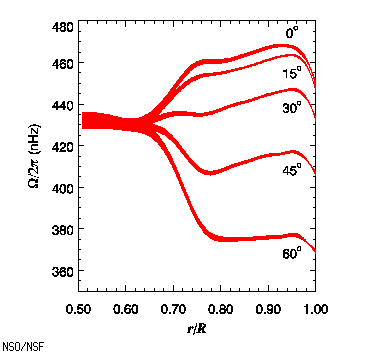
Tachocline
Encyclopedia

Sun
The Sun is the star at the center of the Solar System. It is almost perfectly spherical and consists of hot plasma interwoven with magnetic fields...
between the radiative interior and the differentially rotating
Differential rotation
Differential rotation is seen when different parts of a rotating object move with different angular velocities at different latitudes and/or depths of the body and/or in time. This indicates that the object is not solid. In fluid objects, such as accretion disks, this leads to shearing...
outer convective zone. It is in the outer third of the sun (by radius). This causes the region to have a very large shear as the rotation rate changes very rapidly. The convective exterior rotates as a normal fluid with differential rotation with the poles rotating slowly and the equator rotating quickly. The radiative interior exhibits solid-body rotation, possibly due to a fossil field
Fossil stellar magnetic field
Fossil stellar magnetic fields or fossil fields are proposed as possible interstellar magnetic fields that became locked into certain stars....
The rotation rate through the interior is roughly equal to the rotation rate at mid-latitudes, i.e. in-between the rate at the slow poles and the fast equator. Recent results from helioseismology
Helioseismology
Helioseismology is the study of the propagation of wave oscillations, particularly acoustic pressure waves, in the Sun. Unlike seismic waves on Earth, solar waves have practically no shear component . Solar pressure waves are believed to be generated by the turbulence in the convection zone near...
indicate that the tachocline is located at a radius of at most 0.70 times the Solar radius (measured from the core, i.e., the surface is at 1 solar radius), with a thickness of 0.04 times the solar radius. This would mean the area has a very large shear profile which is one way that large scale magnetic fields can be formed. The geometry and width of the tachocline plays an important role in models of the solar dynamo
Solar dynamo
The solar dynamo is the physical process that generates the Sun's magnetic field. The Sun is permeated by an overall dipole magnetic field, as are many other celestial bodies such as the Earth. The dipole field is produced by a circular electric current flowing deep within the star, following...
by winding up weaker poloidal
Toroidal and poloidal
The earliest use of these terms cited by the Oxford English Dictionary is by Walter M. Elsasser in the context of the generation of the Earth's magnetic field by currents in the core, with "toroidal" being parallel to lines of latitude and "poloidal" being in the direction of the magnetic field...
field to create a much stronger toroidal
Toroidal and poloidal
The earliest use of these terms cited by the Oxford English Dictionary is by Walter M. Elsasser in the context of the generation of the Earth's magnetic field by currents in the core, with "toroidal" being parallel to lines of latitude and "poloidal" being in the direction of the magnetic field...
field. The term tachocline was coined in a paper by Edward Spiegel
Edward Spiegel
Edward A. Spiegel is the Rutherfurd Professor of Astronomy at Columbia University and highly regarded for his work on convection theory and on the application of fluid dynamics to astrophysics.-Career:...
and Jean-Paul Zahn in 1992 by analogy to the oceanic thermocline
Thermocline
A thermocline is a thin but distinct layer in a large body of fluid , in which temperature changes more rapidly with depth than it does in the layers above or below...
.
External links
- Section 3.2 from Living Reviews in Solar Physics
Additional References
- Charbonneau, P., Christensen-Dalsgaard, J., Henning, R., Larsen, R.M., Schou, J., Thompson, M.J., Tomczyk, S., 1999a, “Helioseismic Constraints on the Structure of the Solar Tachocline”, Astrophys. J., 527, 445-460, http://adsabs.harvard.edu/cgi-bin/bib_query?1999ApJ...527..445C.
- Basu, S., Antia, H.M., Narasimha, D., 1994, “Helioseismic Measurement of the Extent of Overshoot Below the Solar Convection Zone”, Mon. Not. R. Astron. Soc., 267, 209-224, http://adsabs.harvard.edu/cgi-bin/bib_query?1994MNRAS.267..209B

